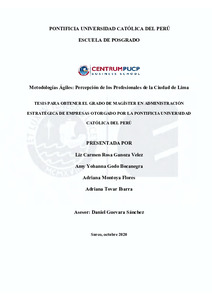| dc.contributor.advisor | Guevara Sánchez, Daniel Eduardo | |
| dc.contributor.author | Ganoza Velez, Liz Carmen Rosa | |
| dc.contributor.author | Godo Bocanegra, Amy Yohanna | |
| dc.contributor.author | Montoya Flores, Adriana | |
| dc.contributor.author | Tovar Ibarra, Adriana | |
| dc.date.accessioned | 2020-11-21T00:59:33Z | |
| dc.date.available | 2020-11-21T00:59:33Z | |
| dc.date.created | 2020 | |
| dc.date.issued | 2020-11-20 | |
| dc.identifier.uri | http://hdl.handle.net/20.500.12404/17529 | |
| dc.description.abstract | La presente investigación tuvo como objetivo identificar los requisitos, beneficios,
limitaciones y estrategias de adopción que presentan las metodologías ágiles aplicadas en las
empresas privadas de la ciudad de Lima. El enfoque de la investigación fue cuantitativo,
descriptivo, no experimental y transversal, empleando como herramienta de recolección de datos
una encuesta online, desarrollada mediante la plataforma Google Forms y validada por siete
especialistas en temas de agilidad; la cual fue realizada a 283 profesionales de diversas áreas que
se encontraban trabajando con metodologías ágiles en empresas privadas de la ciudad de Lima,
que contaban con experiencia en temas de agilidad.
Los resultados obtenidos respondieron a la pregunta general y específicas de la
investigación, mostrando los siguientes hallazgos: los profesionales encuestados refieren que sus
empresas cumplen con promover un cambio del mindset de la organización, con definir
facilitadores (coach ágiles) para la transición hacia la aplicación de metodologías ágiles y
reestructuran el modelo de trabajo de los empleados y de los líderes, como requisitos para
adoptar metodologías ágiles. Asimismo, coinciden en que la mejora en la productividad es el
beneficio que más se está reflejando en sus organizaciones como consecuencia de la aplicación
de metodologías ágiles; mientras que los obstáculos más citados se relacionan a un arraigo a las
metodologías tradicionales asociado a la resistencia al cambio y la cultura dentro de la
organización. Finalmente, coincidieron en que las estrategias más utilizadas para la adopción de
metodologías ágiles en sus empresas fueron “Bottom up”, seguido por la estrategia “Up and Top
Down”, destacando como las metodologías ágiles más utilizadas el SCRUM y KANBAN.
Estos hallazgos podrán ser empleados en futuras investigaciones, sumado al valor de
proporcionar una base informativa para las empresas que deseen emprender un camino hacia la
agilidad, a través de los datos sobre los requisitos, limitaciones, y estrategias que han seguido
otras empresas para aplicar y gozar de los beneficios de las metodologías ágiles. | es_ES |
| dc.description.abstract | The objective of this research was to identify the requirements, benefits, limitations and
adoption strategies presented by the agile methodologies applied in private companies in the city
of Lima. The research focus was quantitative, descriptive, non-experimental and cross-sectional,
using an online survey, created using the Google Forms platform and validated by seven agility
specialists, as a data collection tool; which was carried out to 283 professionals from various
areas who were working with agile methodologies in private companies in the city of Lima, as
well as who had experience in agility.
The results obtained answered the general and specific research question, showing the
following findings: the professionals surveyed report that their companies comply with
promoting a change in the organization's mindset, with defining facilitators (agile coaches) for
the transition to the application of agile methodologies and restructure the work model of
employees and leaders, as requirements to adopt agile methodologies. Likewise, they agree that
the improvement in productivity is the benefit that is most reflected in their organizations as a
consequence of the application of agile methodologies; while the most cited obstacles are related
to an attachment to traditional methodologies associated with resistance to change and culture
within the organization. Finally, they agreed that the most used strategies for the adoption of
agile methodologies in their companies were “Bottom up”, followed by the “Up and Top Down”
strategy, highlighting SCRUM and KANBAN as the most used agile methodologies.
These findings may be used in future research, added to the value of providing an
informative base for companies that wish to embark on a path to agility, through data on the
requirements, limitations, and strategies that other companies have followed to apply and enjoy
the benefits of agile methodologies. | es_ES |
| dc.language.iso | spa | es_ES |
| dc.publisher | Pontificia Universidad Católica del Perú | es_ES |
| dc.rights | Atribución-NoComercial-SinDerivadas 2.5 Perú | * |
| dc.rights | info:eu-repo/semantics/openAccess | es_ES |
| dc.rights.uri | http://creativecommons.org/licenses/by-nc-nd/2.5/pe/ | * |
| dc.subject | Desarrollo ágil de software | es_ES |
| dc.title | Metodologías ágiles: percepción de los profesionales de la ciudad de Lima | es_ES |
| dc.type | info:eu-repo/semantics/masterThesis | es_ES |
| thesis.degree.name | Magíster en Administración Estratégica de Empresas | es_ES |
| thesis.degree.level | Maestría | es_ES |
| thesis.degree.grantor | Pontificia Universidad Católica del Perú. CENTRUM | es_ES |
| thesis.degree.discipline | Administración Estratégica de Empresas | es_ES |
| renati.advisor.dni | 09412483 | |
| renati.advisor.orcid | https://orcid.org/0000-0002-6374-8062 | es_ES |
| renati.author.dni | 42332291 | |
| renati.author.dni | 43791399 | |
| renati.author.dni | 44885789 | |
| renati.author.dni | 45226788 | |
| renati.discipline | 413307 | es_ES |
| renati.level | https://purl.org/pe-repo/renati/level#maestro | es_ES |
| renati.type | https://purl.org/pe-repo/renati/type#tesis | es_ES |
| dc.publisher.country | PE | es_ES |
| dc.subject.ocde | https://purl.org/pe-repo/ocde/ford#5.02.04 | es_ES |






